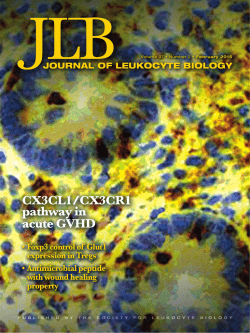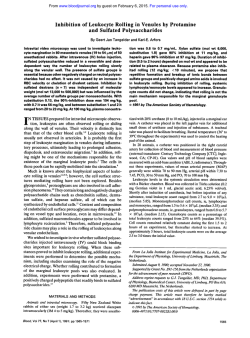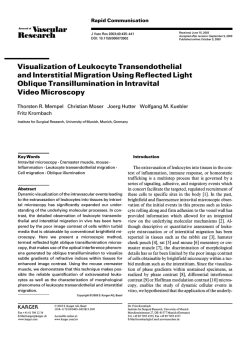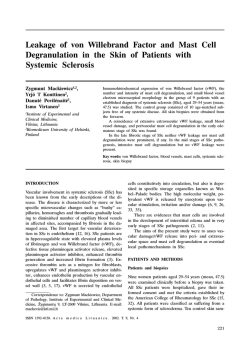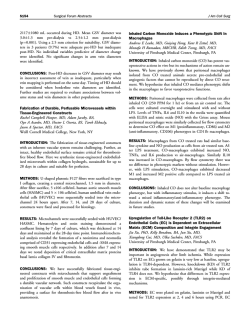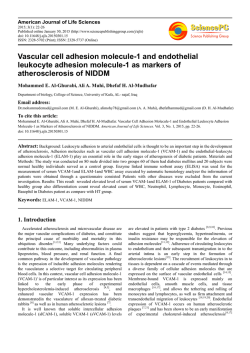
Desmopressin Induces Endothelial P-Selectin Expression
From www.bloodjournal.org by guest on February 6, 2015. For personal use only. Desmopressin Induces Endothelial P-Selectin Expression and Leukocyte Rolling in Postcapillary Venules By Samina Kanwar, Richard C. Woodman, M.C. Poon, Toyoaki Murohara, Allan M. Lefer, Kelly L. Davenpeck, and Paul Kubes Desmopressin, (DDAVP; l-desamino-8-D-arginine vasopressin) increases the release and activity of von Willebrand factor (vWF); however, its effects on the other major constituent ofendothelial Weibel-Palade bodies, P-selectin, has not been investigated. DDAVP-induced P-selectin expression may explain DDAVP's efficacy in bleeding disorders in which vWF levels are normal. Therefore, the objective of this study is t o assess the effect of DDAVP on P-selectin expression on endothelial cells of postcapillary venules in vivo and on human umbilicalvein endothelium in vitro, and t o determine whether DDAVP has direct effects on leukocyte behavior in postcapillary venules. DDAVP (0.1 and 1.0 pg/mL) induced a significant but transient increase in P-selectin expression on human umbilical vein endothelial cells as well as on rat and human platelets. Immunohistochemical analysis of rat postcapillary venules showed that in contrast t o saline, DDAVP injection (1 pglkg, intravenous) induced significant endothelial P-selectin expression.DDAVP administration also induced a rapid and significant increase in leukocyte rolling in rat mesenteric venules in vivo. This response was entirely dependent on P-selectin, as an anti+-selectin antibody rapidly reversed the DDAVP-inducedincrease in leukocyte rolling.DDAVP induced leukocyte rolling in medium (20 t o 40 pm) and large (>40 pm), but not small (c20pm), postcapillary venules. In animals that were treated with DDAVP, there wasa steady and significant increase in leukocyte adhesion. This study shows that DDAVP can directly induce P-selectin expression on endothelium in vitro and in vivo and that the latter response is capable of supporting prolonged leukocyte rolling in rat postcapillary venules. 0 1995 by 7'he American Society of Hematology. F bodies of endothelial cells? Although increases in plasma vWF and factor VI11 activity may explain the efficacy of DDAVP in patients with type I vWD and hemophilia A,',',',"' the mechanism(s) in patients who have normal or elevated vWF remains unknown. Mechanisms independent of endothelial cell release of vWF have also been p r o p ~ s e d . ~ ~ ~ ~ ~ " ~ ~ Besides vWF and its related propolypeptide, P-selectin is the only other constituent within WP bodies that is known to be expressed on endothelial cells and to have an adhesive f ~ n c t i o n . ' ~Recent " ~ studies have shown that endothelial cell expression of P-selectin is important for the very earlyleukocyte-endothelial cell interaction known as leukocyte rolling,17-20 an absolute prerequisite for leukocyte adhesion and Although several agonists have been reported to mediate vWF release and P-selectin upregulation on endothelial cell^,'^^'^^^^ the effect of DDAVP on endothelial cell P-selectin expression and leukocyte-endothelia1 cell interactions has not been characterized. It is conceivable that DDAVP's efficacy in disorders other than type 1 vWD and hemophilia A may be partially caused by its ability to induce P-selectin expression and thereby mediate leukocyte-endothelia1 cell interactions. Therefore, in this study we systematically examined the potential effect of DDAVP on P-selectin expression and function on endothelial cells of postcapillary venules. This was accomplished using immunohistochemical staining of rat mesenteric venules exposed to DDAVP and intravital microscopy to visualize leukocyte behavior in single postcapillary venules. OR MORE THAN a decade desmopressin (DDAVP; 1desamino-8-D-arginine vasopressin), a synthetic derivative of the hormone L-arginine vasopressin, has been effectively used as a hemostatic agent in a variety of acquired and inherited bleeding disorder^."^ DDAVP has been shown to rapidly shorten bleeding time and reduce blood loss in patients withmild and moderate hemophilia A, selected types of von Willebrand disease (vWD) and several forms of platelet dysf~nction.~-' In certain circumstances the need for blood products, and consequently the risk of transfusiontransmitted diseases, has been reduced because of DDAVP administration. Although a single unifying mechanism to explain the beneficial effects of DDAVP in the above heterogeneous group of disorders is lacking, there is considerable evidence to implicate an improvement, albeit transient, in hemostasis after DDAVP administration."' It has generally beenassumed that the mechanism of action of DDAVP is to induce release of preformed high- molecular-weight multimers of von Willebrand factor (vWF) from the Weibel-Palade (WP) From the Immunology Research Groupand the Division of Hematology,University of Calgary,Calgary,Alberta,Canada; andthe Department of Physiology, Jefferson Medical College, Thomas Jefferson University, Philadelphia, PA. Submitted February 21, 1995; accepted May 31, 1995. Supported by grants from the Alberta Heritage Foundation for Medical Research (AHFMR),the Medical Research Council (MRC), and the National Institute of General Medical Sciences of the National Institutes of Health. P.K. is an MRC and AHFMR scholar and R. C.W. is a Clinical Investigator of the AHFMR. Address reprint requests to Samina Kanwar, Departmentof Medical Physiology, Faculty of Medicine, Universityof Calgary, Calgary, Alberta, T2N 4NI Canada. The publication costsof this article weredefrayed in part by page charge payment. This article must therefore be hereby marked "advertisement" in accordance with 18 U.S.C. section 1734 solely to indicate this fact. 0 1995 by The American Society of Hematology. 0006-4971/95/8607-0027$3.00/0 2760 MATERIALS AND METHODS Intravital microscopypreparation. Male Sprague-Dawley rats (180 to 250 g) were maintained on a purified laboratory diet and fasted for 24 hours before surgery. The animals were initially anesthetized with pentobarbitol sodium (65 mgkg body weight), and the right carotid artery and jugular vein were cannulated for systemic arterial blood pressure measurements (Statham F'23A pressure transducer and a Grass physiologic recorder, Scarborough, Canada) and intravenous ( W ) drug administration, respectively. A midline abdominal incision was made and a segment of the mid-jejunal mesenBlood, Vol 86, No 7 (October l ) , 1995: pp 2760-2766 From www.bloodjournal.org by guest on February 6, 2015. For personal use only. 2761 DDAVP, P-SELECTIN, AND LEUKOCYTE ROLLING IN VIVO minutes at room temperature and then washed once with 500 pL tery was gently exteriorized and carefully placed over an optically PBS. The wells were blocked with 1 mL of PBS containing 1% clear viewing pedestal that permitted transillumination of a 2-cm2 bovine serum albumin (wt/vol) and 0.01% NaN3 for 30 minutes segment of mesentery. Small, single unbranched postcapillary vefollowed by incubation with 100 pL of the primary antibody (S121 nules were visualized and the following parameters were measured: solution (10 pg/mL) for 30 minutes. This antibody was kindly provenular diameter, leukocyte rolling and adhesion, leukocyte rolling vided by Dr R. McEver (University of Oklahoma). After three velocity, centerline red blood cell ( W C ) velocity, and shear rates. washes with 0.05% ’TWEEN 20 (Sigma Chemical CO, St Louis, This preparation has been extensively used by us25-27 and other^^^-^" MO)/PBS, 100 pL of the secondary antibody (peroxidase-labeled to examine leukocyte-endothelia1cell interactions in vivo. goat-antimouse IgG; Kirkegaard and Perry Laboratories Inc, MaryExperimental protocol. Immediately upon finding a postcapilland) was added to the wells, incubated for 30 minutes, and washed lary venule, the image was recorded for 5 minutes followed by three three times. A substrate solution, ABTS peroxidase substrate (Kiradditional 5- minute recordings at 15, 30, and 60 minutes. For each kegaard and Perry Laboratories Inc), was then added to the wells set of experiments, all animals were pretreated before laparotomy and the reaction allowed to develop for 30 minutes. Absorbance was with sodium cromoglycate (5 mgkg IV) to minimize surgically then measured at 405 nm. induced leukocyte rolling as previously de~cribed.~’ Animals reFlow cytometric analysis of P-selectin expression on platelets. ceived DDAVP in normal saline at 1 pgkg as an IV bolus. In other Flow cytometric analysis of P-selectin expression on rat and human animal models, investigators have used DDAVP ranging from 0.3 platelets was performed by a method previously de~cribed.~’ In brief, to 4.0 pgkg body weight and have demonstrated enhanced hemoblood was collected from six male Sprague-Dawley rats and was static and antidiuretic effe~ts.~’”~ The mesentery was continuously anticoagulated with sodium citrate phosphate buffer (Sigma Chemisuperfused with warmed bicarbonate-buffered saline, and leukocyte cal CO, St Louis, MO). Human blood was obtained from healthy rolling and adhesion in the postcapillary venules were recorded for adult volunteers. Platelet-rich plasma (PM) was obtained and centrithe remainder of the experiment. To determine if the DDAVP-induced leukocyte rolling was mediated fuged to form a platelet-rich pellet. The pellet was washed and resuspended in Dulbecco’s PBS. Aliquots of the platelet suspensions by P-selectin, another series of experiments was conducted. In these experiments, at 5 minutes of the experimental protocol, animals received were either incubated with buffer alone (unstimulated) or stimulated with hydrogen peroxide (HZOz; 100 pmoVL),aknown P-selectin DDAVP followed15 minutes laterby 2 mgkg of an immunoneutralizinducer, or DDAVP (0.1 pg/mL) at 37°C for 15 minutes without inganti-P-selectinantibody,PB1.3(P-selectinblocking IgGI-clone stirring. The platelet suspensions werethen treated withhuman our 352;CytelCorp. San Diego,CA).Dose-responsestudiesfrom blocking IgG (4.0 mg/mL; Sigma Chemical CO)and then the primary laboratory have previously shown that PB1.3 at 2 mgkg completely inhibitedP-selectin-dependentleukocyterollinginvivo.”Although anti-P-selectin antibody, PB 1.3 (20 pg/mL; Cytel Corp) was added and maintained at4°C for 60 minutes. The platelets were then medium-sized (20 to 40 pm in diameter)postcapillaryvenules are generally used to study leukocyte rolling in v ~ v o ~ ~ -in” a. ~separate ’ washed and F(ab’), fragments ofa goat-antimouse IgG-phycoerseries of experimentswealsoexaminedtheeffect of DDAVPon ythrin conjugate (Tago, Burlingame, CA) were used as secondary leukocyte rolling in postcapillary venules of various diameters: small antibody, and the cells analyzed by flow cytometry (FACScan; Bec(<20 pm), medium (20 to 40 pm), and large (>40pm). ton Dickinson, San Jose, CA). P-selectin expression in vivo. Thirty minutes after DDAVP adStatistical analysis. Data were analyzed using an analysis of ministration the superior mesenteric artery and vein were both cannuvariance and the Student’s t-test witha bonferroni correction for lated for perfusion of the mesenteric circulation. The ileum was then multiple comparisons. All values are expressed as means 2 SE with perfused free of blood with modified Krebs-Henseleit buffer warmed significance at P < .05. to37°C and bubbled with 95% O2 and 5% COz. The tissue was subsequently fixed in4% paraformaldehyde and immunohistochemiRESULTS cal localization of P-selectin accomplished using a modified avidinTable 1 summarizes the baseline hemodynamic paramebiotin immunoperoxidase technique as previously described.35Thirty ters in animals before (0 minutes) and after (60 minutes) venules were examined and the percentage of positive staining veDDAVP administration. There were no significant differnules determined. For control purposes similar surgical procedures ences in RBC velocity, venular diameter, and shear rates were also performed on a group of sham operated animals that over time with DDAVP treatment. These data are consistent received only saline. We also measured concentrations of vWF in rat plasma before and after DDAVP administration using an enzymewith the observations that DDAVP acts through a V2 (vasolinked immunosorbent assay previously de~cribed.’~ pressin)-receptor on endothelium, rather than a VI-receptor, P-selectin expression on human umbilical vein endothelial cells which is found primarily on smooth muscle cells and causes (HUVEC) in vitro. Endothelial cells were isolated from human contra~tion.~~ Table 1 also shows that DDAVP did not induce umbilical cords as previously described.26Briefly, umbilical cord changes in leukocyte rolling velocity. veins were rinsed of formed blood elements with phosphate-buffered DDAVP administration at 5 minutes induced a significant saline (PBS) containing penicillin (100 U/mL) and streptomycin increase in the flux of rolling leukocytes that was sustained (100 pg/mL). Collagenase (2.5 mg/mL; 149 U h g ) was instilled into the vein and the cord incubated for 20 minutes at 37°C and gently massaged to cause detachment of endothelial cells from the vessel Table 1. Baseline Hemodynamic Parameters in Animals Before wall. The digest was collected into centrifuge tubes, the collagenase (time 0 minutes) and After (time 60 minutas) inactivated with fetal calf serum, and centrifuged (400g for 10 miDDAVP Administration nutes at 25‘C). The pellet was resuspended in M199, without cell mitogens, containing 10% fetal calf serum and antibiotics plated Time 0 rnin Time 60 rnin onto 48-well plates. Cultures were incubated in 5% COz, at 37°C RBC velocity (rnm/s) 2.0 3- 0.3 2.2 3- 0.5 and 96% humidity, for 24 hours. Venular diameter (pm) 32.7 2 0.8 3- 0.8 31.5 The monolayers were exposed to Hanks’ buffered salt solution or 306 2 56 Shear rates (S”) 346 ? 98 a solution of DDAVP (0.1 or 1.O yg/mL) for 2, 10,20, or 60 minutes. Leukocyte rolling velocity (pmls) 40.8 3- 3.8 43.0 ? 2.2 The cells were then fixed with 500 p L of cold 1% formalin for 30 ~ ~ ~~~~ From www.bloodjournal.org by guest on February 6, 2015. For personal use only. 2762 KANWARET * T rn Ev 5 0 t 0 : 5 .g p2 20 40 Z- 0 b 30 D D j P Ez 111 F 5l A a 3 X g& B- Fro 2E! 5 - 0 15 60 W 50 1 % X- y” !. 0 & 40 - 30 - Z Q zz 2 3:20l&- 0 10 - l x S 0 - 0 vessels 0 vessels > 40 urn < 20 um * T fi DDAW c/ 0 0 15 TIME (min) k 13 0- , for the entire duration of the experiment (Fig 1). The vessels used in this experiment ranged in diameter from 20 to 40 pm (medium size). DDAVP also induced a significant and sustained increase in leukocyte rolling in relatively large (>40 pm) venules (Fig 2). The peak increase in leukocyte rolling flux was similar in these vessels as in the mediumsized (20 to 40 pm) venules shown inFig 1. However, DDAVP treatment did not support leukocyte rolling in postcapillary venules smaller than 20 pm (Fig 2 ) . The number of adherent leukocytes per 100 pm venule length in medium-sized vessels in control and DDAVPtreated animals is illustrated in Fig 3 . In contrast to controls, animals that received DDAVP had a steady, time-dependent U 0 25 1 Fig 1. DDAVPadministration at 5 minutes of the experimental protocol induced a significant increase in the flux of rolling leukocytes in medium venules (20 to 40 pm). This increase in leukocyte rolling was maintainedfor the entire durationof the experiment( 8 0 minutes), n= 6. * P < .05 relative to time 0 minutes. rn $10- O Z l0 o 1 0 CONTROL 0 DDAVP Eg V TIME (min) 3 *+1 G2 0 ETl AL 60 Fig 2. This figure shows the induction of leukocyte rolling in venules of various sizes. DDAVP induces a significant increase in leukocyte rolling in large postcapillary venules(>40 p m in diameter, n = 8). but has no effect on leukocyterolling in small venules (<20 pm, n = 4). * P < .05 relative to 0 minutes. 0 15 30 TIME (min) 60 Fig 3. This figure shows the number of adherentleukocytes within a given segmentof medium-sized (20 to 40 p m in diameter) postcapillary venules. DDAVP administered at 5 minutes induces a subtle but significant increase in leukocyte adhesionat 60 minutes, n = 6. * P < .05 relative to time 0 minutes value. t P < .05 relative to respective control value. increase in leukocyte adhesion that reached significance at 60 minutes. It should be noted that the increase in adhesion in some venules was as high as 22 cells/100 pm length of venules. Comparatively, leukocyte adhesion with pro-inflammatory agents such as platelet-activating factor and leukotriene B, is approximately 15 to 30 cells/100 pm length venule,3’ suggesting a reasonably profound increase in leukocyte adhesion with DDAVP. Figure 4 shows that DDAVP induced a rapid increase in leukocyte rolling flux that could be rapidly and completely anti-P-selectin antibody rn W Ex 5 ‘g 2: 0 40 . 30 0 % 20 27 r40 10 3 Er X 0 3 0 15 30 60 TIME (min) Fig 4. DDAVP increases leukocyte rolling via P-selectin. DDAVP administration at 5 minutes induces a significant increase in leukocyte rolling in medium sized vessels (20 to 40 p m in diameter). An anti-P-selectin antibody, PB1.3, administered at 20 minutes rapidly reverses the DDAVP-induced increasein leukocyte rolling, n = 4. * P < .05 relative to time 0 minutest P < .05 relative to time 15 minutes. From www.bloodjournal.org by guest on February 6, 2015. For personal use only. DDAVP,P-SELECTIN, AND LEUKOCYTE ROLLING IN VIVO 2763 B Fig 5. Immunohistochemicalanalysis of P-selectinexpression in vivo in DDAVP-treated (A) and control (B)rats. DDAVP significantly increased P-selectin expressionin medium-sized postcapillary venules compared with similar-sized venules from control rats. reversedwithananti-P-selectin antibody, PB1.3. This PB 1.3-associated reduction inleukocyte rolling persisted for the remainder of the experiment. To confirm that DDAVP was inducing W P body mobilization and P-selectin expression, immunohistochemical analysis of P-selectin expression and plasma levels of vWF were measured in untreated and DDAVP-treated animals. In animals treated with DDAVP, 51.2% ? 7.3% of postcapillary venules were strongly positive for P-selectin staining. This is in contrast to tissue sections from animals treated with saline alone in which only 13.4% ? 2.3%of venules stained positive for P-selectin. Virtually no P-selectin expression was observed in arterial endothelium or in postcapillary venules smaller than 20 pm in diameter (data not included) from either group of animals. Figure 5 shows P-selectin expression in DDAVP-treated (A) and control (B) mesenteric preparations. Plasma concentration of v W F was significantly increased after DDAVP administration from 0.39 t 0.03 to 0.62 ? 0.1 U/mL (n = 5). To determine whether DDAVP induced P-selectin expression on human endothelium, we exposed HUVEC to DDAVP.In contrast to untreated HUVEC,incubationof HUVECwith DDAVP (0.1and1.0 pg/mL) increased P- selectin expression within 2 minutes (Fig 6). This response was maintained for at least 20 minutes. Interestingly, at 60 minutes the DDAVP (0.1 or 1.0 pg/mL) induced P-selectin expression had returnedto baseline. This transient P-selectin expression in vitro is consistent with results of endothelial cell P-selectin expression induced by other agonists, includthrombin ing and It should be noted that DDAVP did not induce P-selectin expression on passaged endothelial cell cultures or primary cultures that received a cocktail of growth mitogens (Endothelial Mitogen obtained from Biomedical Technologies, Inc, Stoughton, MA) overnight (data not shown). To confirm that DDAVPalso affected platelet^,'^ we measured P-selectin expression on rat and human platelets.Table 2 shows the percent positive staining for P-selectin on unstimulated platelets and platelets stimulated with H202or DDAVP. The anti-P-selectin antibody bound to only asmall percentage of rat and human platelets. However, after incubation with H202 and DDAVP the binding of the anti-Pselectin antibody to both the rat and human platelet surface was significantly increased, suggesting thatboth H202 and DDAVP significantly increase platelet P-selectinexpression. From www.bloodjournal.org by guest on February 6, 2015. For personal use only. 2764 KANWAR ET AL 0 10 20 30 40 50 60 DURATION OF EXPOSURE TO STIMULUS (min) Fig 6. This figure shows a dosaresponse of DDAVP-inducadPselectin expression on monolayers of HUVEC in vitro. After 2, IO, and 20 minuter of exposure, DDAVP inducad significant P-selectin expressionat 0.1 (V)and 1.0 pg/mL (0).By 60 minutea,DDAVPinduced P-selectin expression returned to control values.(V) Desmopressin (0 pg/mL). * P c .05 relative to respective control. DISCUSSION Commonly the beneficial hemostatic effects of DDAVP have been attributed to the release of high-molecular-weight v W F multimers from endothelial cells due to exocytosis of WP bodies.lS9Increased plasma levels of vWF and factor VI11 would certainly explain the efficacy of DDAVP in type I vWD and hemophilia A; however, in the other DDAVPresponsive bleeding disorders, associated with normalor elevated plasma levels of vWF, the mechanism of action of DDAVP remains unknown. It has been suggested that DDAVP may have additional mechanism(s) of action irrespective of DDAVP's ability to increase plasma VWF.'.'." One potential consideration is a direct and local effect of DDAVP on endothelial cells independent of vWF release. In this study, immunohistochemical staining of rat postcapillary venules showed that DDAVP induced significant endothelial P-selectin expression. This may be a direct effect of DDAVP on the endothelium inasmuch as DDAVP also directly caused P-selectin expression on cultured endothelial cells. The effects of DDAVP on endothelial P-selectin expression in vivo has, to our knowledge, not been previously reported. It might be predicted that because P-selectin is stored within WP bodies of endothelial cells, DDAVP would influence P-selectin expression in a manner similar to other endothelial cell secretagogues. Thrombin, calcium ionophore, complement components C5b-9, phorbol esters, and histamine have all been previously reported to increase Pselectin expression simultaneously with the release of vWF.'~,'~," Stimulation with these agonists leads to a rapid exocytosis of WP bodies releasing preformed vWF multimers and exposing P-selectin on the surface of the plasma membrane.24P-selectin upregulation occurred within 5 minutes and persisted for nearly 30 minutes before under- going re-endocytosis." Our results with DDAVP showed a similar time course of endothelial P-selectin expression in vitro, but a more prolonged time course in vivo. We have also shown for the first time that DDAVP has a direct effect on rat and human platelet P-selectin expression in vitro. The functional significance of DDAVP-induced platelet Pselectin expression remains to be characterized. In addition to the increased P-selectin expression in vivo, there was a profound increase in leukocyte rolling after DDAVP administration that persisted for the entire duration of the experiment (60 minutes). These two events were causally related as ananti-P-selectin antibody completely reversed the DDAVP-induced increase in leukocyte rolling. These observations suggest that DDAVP directly stimulates vascular endothelial cells to express P-selectin, which is functionally manifested as increased leukocyte rolling in postcapillary venules. The increase in leukocyte rolling was evident in medium and large postcapillary venules, but not in small venules. Although it is tempting to conclude from this functional data that P-selectin expression was invoked only in vessels larger than 20 pm, it is also possible that in these very small vessels wherein the diameter of the leukocyte approaches that of the vessel lumen, recruitment of additional rolling cells may be less likely to occur. Although this is the first documentation that DDAVP directly affects leukocyte rolling via P-selectin expression, there is ample evidence both in vitro and in vivo to implicate a role for P-selectin as an important adhesion molecule involved in leukocyte rolling. Reconstitution of P-selectin in lipid bilayers or activation of the endothelium with histamine has been shown to support leukocyte rolling under shear conditions in flow ~harnbers.'~,*~ More recently, Kubes and Kanwar3' and Asako et a1', showed that histamine administration can support prolonged (60 minutes), P-selectin-dependent leukocyte rolling in postcapillary venules. DDAVP induced a very similar response in vivo to that reported for histamine in that the P-selectin-dependent leukocyte rolling persisted for 60 minutes despite the fact that in vitro, DDAVP, as well as histamine, only induced transient Pselectin expression (<W minutes). A possible explanation for this difference may be that in vitro endothelium isolated from large veins responds differently than the postcapillary venular endothelium, which is the normal site of leukocyte rolling in vivo. It is interesting that DDAVP has previously been reported not to mobilize WP bodies to the surface of endothelial cells in vitro?' However, in those studies, passaged endothelium Table 2. Flow Cytometric Analysis of P-Selectin Expression RatPlatelets Platelets Human % Positive Cells n 14 rt 6 76 ? 5* 45 rt 2 t 4 4 3 % Positive Cells n ~~ Unstimulated H20, (100 pmol/L) DDAVP (0.1 pg/mL) * P < .01 relative to unstimulated group. t P < .05 relative to unstimulated group. 23 rt 9 63 -c 4* 55 rt 1 4 t 4 4 3 From www.bloodjournal.org by guest on February 6, 2015. For personal use only. DDAVP, P-SELECTIN, AND LEUKOCYTE ROLLING IN VIVO 2765 9. Vischer UM, Wagner DD: von Willebrand factor proteolytic was used whereas herein we used primary cultures of endoprocessing and multimerization precede the formation of Weibelthelium.Indeed, DDAVP hadno effect inour systemon passaged endothelium or on primary cultures wherein growthPalade bodies. Blood 83:3536, 1994 10. Fressinaud E, Federici AB, Castaman G,Rothschild C, Rodefactop were added (data not shown). The need for primary ghiero F, Baumgartner HR, Mannucci PM, Meyer D: The role of culturestoinduceP-selectinexpression is consistentwith platelet von Willebrand factor in platelet adhesion and thrombus observations by other investigators16 and highlights the very formation: A study of 34 patients with various subtypes of type I specific conditions required to mimic the in vivo situation. von Willebrand disease. Br J Haematol 86:327, 1994 Collins et a l l 6 have reported that trypsin (commonly used to 11. Lethagen S, Nilsson I M : DDAVP-induced enhancement of platelet retention: Its dependence on platelet-von Willebrand factor passage endothelium)affects WP body mobilization,perhaps explaining the lackof effect of DDAVP on P-selectin expres- and the platelet receptor GP IIbAIIa. Eur J Haematol 49:7, 1992 12. Barnhart MI, Chen S, Lusher JM: DDAVP Does the drug sion on passaged endothelial cells. have a direct effect on the vessel wall? Thromb Res 31:239, 1983 The results from our studies have several important impli13. Wun T, Paglieroni T, Lachant NA: Desmopressin stimulates cations.First,theysupportthegrowingbody of evidence P-selectin expression on human platelets in vitro. Blood 84:159a, for theassigned roleof P-selectin mobilizedfrom WP bodies 1994 (abstr, suppl 1) in mediating leukocyterolling.’”20Second, DDAVP’s ability 14. Bonfanti R, Furie BC, Furie B, Wagner DD:PADGEM to enhance leukocyte-endothelialcell interactions raises the (GMP140) is a component of Weibel-Palade bodies of human endoquestion as to whether DDAVP’s efficacy in disorders other thelial cells. Blood 73:1109, 1989 thantype 1 vWD and hemophilia A (inwhich DDAVP’s 15. Hattori R, Hamilton KK, Fugate RD. McEver RP, Sims PJ: mechanism of action is throughthe release of endothelial Stimulated secretion of endothelial von Willebrand factor is accompanied by rapid redistribution to the cell surface of the intracellular vWF”~)is through adirect effect onendothelial cells to granule membrane protein GMP-140. J Biol Chem 264:7768, 1989 enhanceP-selectinexpression.WhetherthisDDAVP-in16. Collins PW, Macey MG, Cahill MR, Newland AC: von Willeducedendothelial cell P-selectinexpression is associated brand factor release and P-selectin expression is stimulated by withimprovedplatelet-endothelialinteractionsremainsto be characterized. The clinical consequences and applications thrombin and trypsin but not L 1 in cultured human endothelial cells. Thromb Haemost 70:346, 1993 of these novel observations are incompletely understood but 17. Dore M, Korthuis RJ, Granger DN, Entman ML, Smith CW: merit further investigation. P-selectin mediates spontaneous leukocyte rolling in vivo. Blood ACKNOWLEDGMENT We are grateful to Dr R. McEver for the generous gift of the antiP-selectin antibody, S12. We would also thank P. Reinhardt and Dr Gary Sinclair for technical assistance. REFERENCES 1. Mannucci PM: Desmopressin: A nontransfusional form of treatment for congenital and acquired bleeding disorders. Blood 72:1449, 1988 2. Mannucci PM: Desmopressin (DDAVP) for treatment of disorders of hemostasis. Prog Hemost Thromb 72:19, 1986 3. Rose EH, Aledort LM: Nasal spray desmopressin (DDAVP) for mild hemophilia A and von Willebrand disease. Ann Intern Med 114563, 1991 4. Mannucci PM, Vicente V, Vianello L, Cattaneo M, Alberca I, Coccato MP, Faioni E, Mari D: Controlled trial of desmopressin in liver cirrhosis and other conditions associated with a prolonged bleeding time. Blood 67:1148, 1986 5 . Cattaneo M, Moia M, Della Valle P, Castellana P, Mannuci PM: DDAVP shortens the prolonged bleeding times of patients with severe von Willebrand disease treated with cryoprecipitate. Evidence for a mechanism of action independent of released von Willebrand factor. Blood 74:1972, 1989 6. Holmberg L, Nilsson IM, Borge L, Gunnarsson M, Sjorin E: Platelet aggregation induced by 1-desamino-8-D-arginine vasopressin (DDAVP) in type IIb von Willebrand’s disease. N Engl J Med 309:816, 1983 7. Miller JL, Boselli BD, Kupinski JM: In vivo interaction of von Willebrand factor with platelets following cryoprecipitate transfusion in platelet-type von Willebrand’s disease. Blood 63:226, 1984 8. Sloand EM, Alyono D, Klein HG, Chang P, Yu M, Lightfoot FG, Kessler G: l-deamino-8-D-arginine vasopressin (DDAVP) increases platelet membrane expression of glycoprotein Ib in patients with disorders of platelet function and after cardiopulmonary bypass. Am J Hematol 46: 199, 1994 82:1308, 1993 18. Fiebig E, Ley K, Arfors KE: Rapid leukocyte accumulation by “spontaneous” rolling and adhesion inthe exteriorized rabbit mesentery. Int J Microcirc Clin Exp 10:127, 1991 19. Jones DA, Abbassi 0, McIntire LV, McEver RP, Smith CW: P-selectin mediates neutrophil rolling on histamine-stimulated endothelial cells. Biophys J 65:1560, 1993 20. Mayadas TN, Johnson RC, Rayburn H, Hynes RO, Wagner DD: Leukocyte rolling and extravasation are severely compromised in P-selectin-deficient mice. Cell 74:541, 1993 21. Von Andrian UH, Hansel1 P,Chambers JD, Berger EM, Filho IT, Butcher EC, Arfors KE: L-selectin function is required for p2integrin-mediated neutrophil adhesion at physiological shear rates in vivo. Am J Physiol 263:H1034, 1992 22. Lindbom L, Xie X,Raud J, Hedqvist P: Chemoattractantinduced firm adhesion of leukocytes to vascular endothelium in vivo is critically dependent on initial leukocyte rolling. Acta Physiol Scand 146:415, 1992 23. Lawrence MB, Springer TA: Leukocytes roll on a selectin at physiologic flow rates: Distinction from and prerequisite for adhesion through integrins. Cell 65859, 1991 24. Hattori R, Hamilton KK, McEver RP, Sims PJ: Complement proteins C5b-9 induce secretion of high molecular weight multimers of endothelial von Willebrand factor and translocation of granule membrane protein GMP-I40 to the cell surface. J Biol Chem 264:9053, 1989 25. Wallace JL, Hogaboam CM, Kubes P Immunopathology of NSAID-gastropathy: Inhibitory effects of interleukin-l and cyclosporin A. Ann NY Acad Sci 664:400, 1992 26. Woodman RC, Reinhardt PH, Kanwar S, Johnston FL, Kubes P: The effects of human neutrophil elastase (HNE) on neutrophil function in vitro and in inflamed microvessels. Blood 82:2188, 1993 27. Kubes P, Kanwar S, Niu X-F, Gaboury J: Nitric oxide synthesis inhibition induces leukocyte adhesion via superoxide and mast cells. FASEB J 7:1293, 1993 28. Suematsu M, Kurose I, Asako H, Miura S, Tsuchiya M:In From www.bloodjournal.org by guest on February 6, 2015. For personal use only. 2766 vivo visualization of oxyradical-dependent photoemission during endothelium-granulocyte interaction in microvascular beds treated with platelet-activating factor. J Biochem 106:355, 1989 29. Asako H,Wolf RE, Granger DN, Korthuis RJ: Phalloidin prevents leukocyte emigration induced by proinflammatory stimuli in rat mesentery. Am J Physiol 263:H1, 1992 30. Arndt H, Smith CW, Granger DN: Leukocyte-endothelial cell adhesion in spontaneously hypertensive and normotensive rats. Hypertension 21:667, 1993 31. Kubes P, Kanwar S: Histamine induces leukocyte rolling in post-capillary venules: A P-selectin-mediated event. J lmmunol 152:3570, 1994 32. Vilhardt H, Barth T, Melin P, Aurell C-J: Antidiuretic activity and release of factor VI11 byvasopressin analogues. Eur J Pharmacol 232:223, 1993 33. Paloma MJ, Paramo JA, Rocha E: Effect of DDAVP on endotoxin-induced intravascular coagulation in rabbits. Thromb Haemost 68:306, 1992 34. Kaufman S, Stewart M, Gordon PA: Evaluation of hemostatic activity of desamino-D-arginine vasopressin (DDAVP) in uremic rats. Thromb Res 73:53, 1994 35. Davenpeck K L , Gauthier TW, Lefer AM: Inhibition of endo- KANWAR ET AL thelial-derived nitric oxide promotes P-selectin expression and actions in the rat microcirculation. Gastroenterology 107:1050, 1994 36. Poon M-C, Hoar DI, Low S, Pon JK, Anand S, Sinclair GD: Hemophilia A carrier detection by restriction fragment length polymorphism analysis and discriminant analysis basedonELISA of factor VI11 and vWf. J Lab Clin Med 119:751, 1992 37. Weyrich AS, Ma X-L, Lefer DJ, Albertine KH, Lefer AM: In vivo neutralization of P-selectin protects feline heart and endothelium in myocardial ischemia and reperfusion injury. J Clin Invest 9 1 :2620, 1993 38. Richardson DW, Robinson AG: Desmopressin. Ann lntern Med 103:228, 1985 39. Gaboury J, Woodman RC, Granger DN, Reinhardt P, Kubes P: Nitric oxide prevents leukocyte adherence: Role of superoxide. Am J Physiol 265:H862, 1993 40. Asako H, Kurose I, Wolf R, DeFrees S, Zheng Z-L, Phillips ML, Paulson JC, Granger DN: Role of H1 receptors and P-selectin in histamine-induced leukocyte rolling and adhesion in postcapillary venules. J Clin Invest 93:1508, 1994 41. Hashemi S, Palmer DS, Aye MT, Ganz PR: Platelet-activating factor secreted by DDAVP-treated monocytes mediates von Willebrand factor release from endothelial cells. J Cell Physiol 154:496, I993 From www.bloodjournal.org by guest on February 6, 2015. For personal use only. 1995 86: 2760-2766 Desmopressin induces endothelial P-selectin expression and leukocyte rolling in postcapillary venules S Kanwar, RC Woodman, MC Poon, T Murohara, AM Lefer, KL Davenpeck and P Kubes Updated information and services can be found at: http://www.bloodjournal.org/content/86/7/2760.full.html Articles on similar topics can be found in the following Blood collections Information about reproducing this article in parts or in its entirety may be found online at: http://www.bloodjournal.org/site/misc/rights.xhtml#repub_requests Information about ordering reprints may be found online at: http://www.bloodjournal.org/site/misc/rights.xhtml#reprints Information about subscriptions and ASH membership may be found online at: http://www.bloodjournal.org/site/subscriptions/index.xhtml Blood (print ISSN 0006-4971, online ISSN 1528-0020), is published weekly by the American Society of Hematology, 2021 L St, NW, Suite 900, Washington DC 20036. Copyright 2011 by The American Society of Hematology; all rights reserved.
© Copyright 2026
